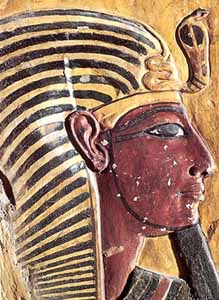
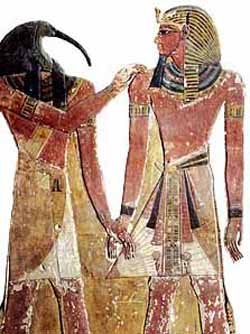
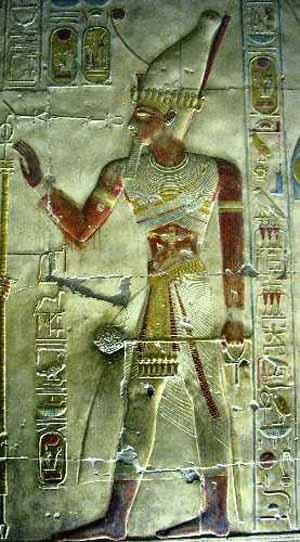



Menmaatre Seti I (or Sethos I as in Greek) was a Pharaoh of the New Kingdom Nineteenth dynasty of Egypt, the son of Ramesses I and Queen Sitre, and the father of Ramesses II. As with all dates in Ancient Egypt, the actual dates of his reign are unclear, and various historians claim different dates, with 1294 BC - 1279 BC and 1290 BC to 1279 BC being the most commonly used by scholars today.
The name Seti means "of Set", which indicates that he was consecrated to the god Set (commonly "Seth"). As with most Pharaohs, Seti had several names. Upon his ascension, hue became Menmaatre, in Egyptian, which means " Eternal is the Justice of Re." Manetho incorrectly considered him to be the founder of the 19th dynasty, and gave him a reign length of 55 years, though no evidence has ever been found for so long a reign.
Seti I's reign length was either 11 or 15 full years. Egyptologist Kenneth Kitchen has estimated that it was 15 years, but as there are no dates recorded for Seti I after his 11th Year, and as he is otherwise quite well documented in historical records, other scholars suggest that a continuous break in the record for his last four years is unlikely.
Peter J. Brand noted that the king personally opened new rock quarries at Aswan to build obelisks and colossal statues in his Year 9. This event is commemorated on two rock stelas in Aswan. However, most of Seti's obelisks and statues - such as the Flaminian and Luxor obelisks were only partly finished or decorated by the time of his death since they were completed early under his son's reign based on epigraphic evidence.
Ramesses II used the prenomen 'Usermaatre' to refer to himself in his first year and did not adopt the final form of his royal title - 'Usermaatre Setepenre' - until late into his second year. Brand aptly notes that this evidence calls into question the idea of a 15 Year reign for Seti I and suggests that "Seti died after a ten to eleven year reign" because only two years would have passed between the opening of the Rock Quarries and the partial completion and decoration of these monuments.
This explanation conforms better with the evidence of the unfinished state of Seti I's monuments and the fact that Ramesses II had to complete the decorations on "many of his father's unfinished monuments, including the southern half of the Hypostyle Hall at Karnak and portions of his father's temples at Gurnah and Abydos" during the very first Year of his own reign.
Critically, Brand notes that the larger of the two Aswan rock stelas state that Seti I "has ordered the commissioning of multitudinous works for the making of very great obelisks and great and wondrous statues (ie: colossi) in the name of His Majesty, L.P.H. He made great barges for transporting them, and ships crews to match them for ferrying them from the quarry." (KRI 74:12-14) However, despite this promise, Brand stresses that
The German Egyptologist Jurgen von Beckerath also accepts that Seti I's reign lasted only 11 Years. Seti's Highest known date is Year 11, IV Shemu day 12 or 13 on a sandstone stela from Gebel Barkal but he would have briefly survived for 2 to 3 days into his Year 12 before dying based on the date of Ramesses II's rise to power. Seti I's accession date has been determined by Wolfgang Helck to be III Shemu day 24, which is very close to Ramesses II's known accession date of III Shemu day 27.
After the enormous social upheavals generated by Akhenaten's religious reform, Horemheb, Ramesses I and Seti I's main priority was to re-establish order in the kingdom and to reaffirm Egypt's sovereignty over Canaan and Syria, which had been compromised by the increasing external pressures from the Hittite state. Seti, with energy and determination, confronted the Hittites several times in battle.
Without succeeding in destroying the Hittites as a potential danger to Egypt, he reconquered most of the disputed territories for Egypt and generally concluded his military campaigns with victories. The memory of Seti I's military successes were recorded in some large scenes placed on the front of the temple of Amun, situated in Karnak.
A funerary temple for Seti was constructed in what is now known as Qurna (Mortuary Temple of Seti I), on the west bank of the Nile at Thebes while a magnificent temple made of white marble at Abydos featuring exquisite relief scenes was started by Seti, and later completed by his son. His capital was at Memphis. He was considered a great king by his peers, but his fame has been overshadowed since ancient times by that of his son, Ramesses II.
Seti I fought a series of wars in Western Asia, Libya and Nubia in the first decade of his reign. The main source for Seti's military activities are his battle scenes on the north exterior wall of the Karnak Hypostyle Hall, along with several royal stela with inscriptions mentioning battles in Canaan and Nubia.
In his first regnal year, he led his armies along the "Ways of Horus," the coastal road that led from the Egyptian city of Tjaru (Zarw/Sile) in the north-east corner of the Egyptian Nile Delta along the northern coast of the Sinai peninsula ending in the town of Canaan in the modern Gaza strip.
The Ways of Horus consisted of a series of military forts, each with a well, that are depicted in detail in the king's war scenes on the north wall of the Karnak Hypostyle Hall. While crossing the Sinai, the king's army fought local Bedouins called the Shasu.
In Canaan, he received the tribute of some of the city states he visited. Others, including Beth-Shan and Yenoam, had to be captured but were easily defeated. The attack on Yenoam is illustrated in his war scenes, while other battles, such as the defeat of Beth-Shan, were not shown because the king himself did not participate, sending a division of his army instead. The year one campaign continued into Lebanon where the king received the submission of its chiefs who were compelled to cut down valuable cedar wood themselves as tribute.
At some unknown point in his reign, Seti I defeated Libyan tribesmen who had invaded Egypt's western border. Although defeated, the Libyans would pose an ever increasing threat to Egypt during the reigns of Merenptah and Ramesses III. The Egyptian army also put down a minor rebellion in Nubia in the 8th year of Seti I. Seti himself did not participate in it although his Crown Prince, the future Ramesses II, may have.
The greatest achievement of Seti I's foreign policy was the capture of the Syrian town of Kadesh and neighboring territory of Amurru from the Hittite Empire. Kadesh had been lost to Egypt since the time of Akhenaten. Tutankhamun and Horemheb had both failed to recapture the city from the Hittites.
Seti I was successful in defeating a Hittite army that tried to defend the town. He entered the city in triumph together with his son Ramesses II and erected a victory stela at the site. Kadesh, however, soon reverted to Hittite control because the Egyptians did not or could not maintain a permanent military occupation of Kadesh and Amurru which were close to the Hittite homelands. It is unlikely that Seti I made a peace treaty with the Hittites or voluntarily returned Kadesh and Amurru to them but he may have reached an informal understanding with the Hittite king Muwatalli on the precise boundaries of the Egyptian and Hittite Empires.
Five years after Seti I's death, however, his son Ramesses II resumed hostilities and made a failed attempt to recapture Kadesh. Kadesh was, henceforth, effectively lost to the Hittites even though Ramesses temporarily occupied the city in his 8th year.
The traditional view of Seti I's wars was that he restored the Egyptian empire after it had been lost in the time of Akhenaten. This was based on the chaotic picture of Egyptian controlled Syria and Palestine seen in the Amarna letters, a cache of diplomatic correspondence from the time of Akhenaten found at Akhenaten's capital at el-Amarna in Middle Egypt. Recent scholarship, however, indicates that the Empire was not lost at this time, except for its northern border provinces of Kadesh and Amurru in Syria and Lebanon.
While evidence for the military activities of Akhenaten, Tutankhamun and Horemheb is fragmentary or ambiguous, Seti I has left us an impressive war monument that glorifies his achievement, along with a number of texts, all of which tend to magnify his personal achievements on the battlefield.
Around Year 9 of his reign, Seti appointed his son Ramesses II as the Crown Prince and his chosen successor, but the evidence for a coregency between the two kings is likely illusory. Peter J. Brand who has published an extensive biography on this Pharaoh and his numerous works, stresses in his thesis that relief decorations at various temple sites at Karnak, Qurna and Abydos which associate Ramesses II with Seti I, were actually carved after Seti's death by Ramesses II himself and, hence, cannot be used as source material to support a co-regency between the two monarchs.
In addition, the late William Murnane who first endorsed the theory of a co-regency between Seti I and Ramesses II later revised his view of the proposed co-regency and rejected the idea that Ramesses II had begun to count his own regnal years while Seti I was still alive.
Finally, Kenneth Kitchen rejects the term co-regency to describe the relationship between Seti I and Ramesses II; he describes the earliest phase of Ramesses II's career as a "prince regency" where the young Ramesses enjoyed all the trappings of royalty including the use of a royal titulary and harem but did not count his regnal years until after his father's death.
This is due to the fact that the evidence for a co-regency between the two kings is vague and highly ambiguous. Two important inscriptions from the first decade of Ramesses' reign, namely the Abydos Dedicatory Inscription and the Kuban Stela of Ramesses II, consistently give the latter titles associated with those of a Crown Prince only, namely the "king's eldest son and hereditary prince" or "child-heir" to the throne "along with some military titles.

The Temple of Seti I at Abydos, Seti I is one of the most remarkable temples ever constructed in Egypt. It has seven sanctuaries, dedicated to: Set 1, Ptah, Re-Harakhte, Amun-Re, Osiris, Isis and Horus.
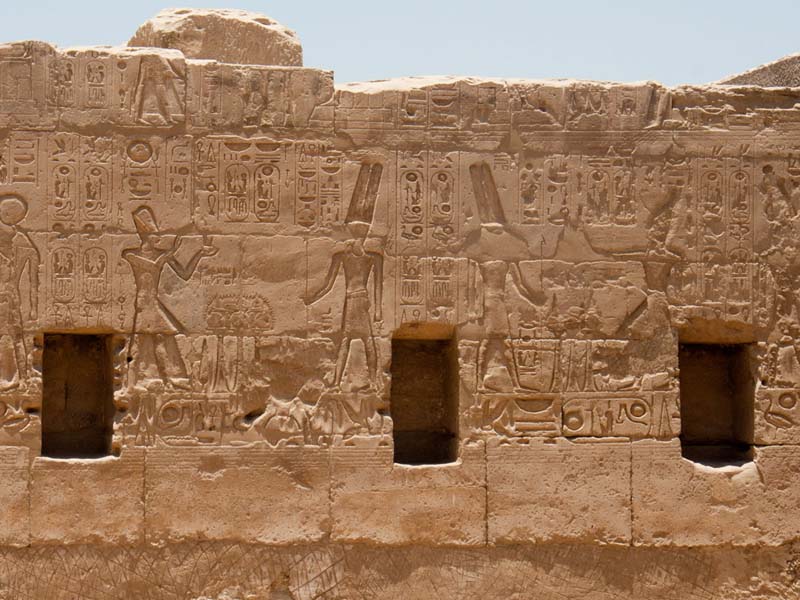

Ceiling Beams Ancient Aircraft
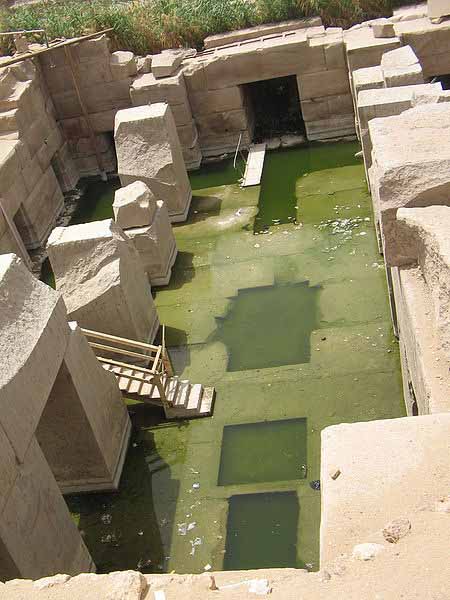
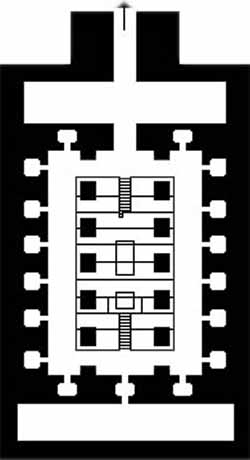
Behind the Temple at Abydos Seti, build another remarkable structure known as the Osireion. It is an integral part of Seti I's funeral complex and is built to resemble an 18th Dynasty Valley of the Kings tomb. It was discovered by archaeologists Flinders Petrie and Margaret Murray who were excavating the site in 1902-3. The Osirion was originally built at a considerably lower level than the foundations of the temple of Seti, who ruled from 1294 - 1279 BC. While there is disagreement as to its true age, despite the fact that it is situated at a lower depth than the structures nearby, that it features a very different architectural approach, and that it is frequently flooded with water which would have made carving it impossible had the water level been the same at the time of construction, Peter Brand says it "can be dated confidently to Seti's reign."
Completely underground, originally a long tunnel decorated with painted scenes from the 'Book of Gates' led to a huge hall. This whole structure with a central mound surrounded by canal water was symbolic of the origins of life from the primeval waters. It was here that Seti rested after his death and before being taken to his tomb in the Valley of the Kings.
Other building projects included a small temple at Abydos dedicated to Seti's father, Ramesses I, his own mortuary temple at Thebes, and his best building project of all, his tomb in the Valley of the Kings. This tomb, one of the few actually completed, was without doubt the finest in the Valley of the Kings, as well as the longest and deepest.
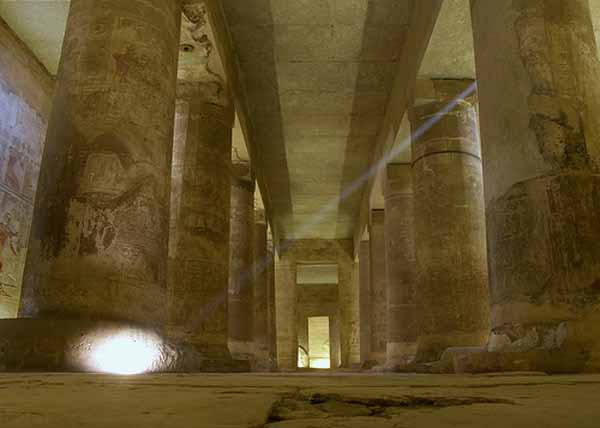
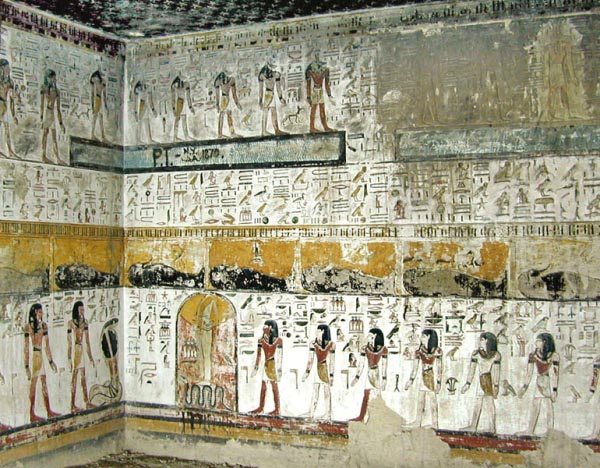
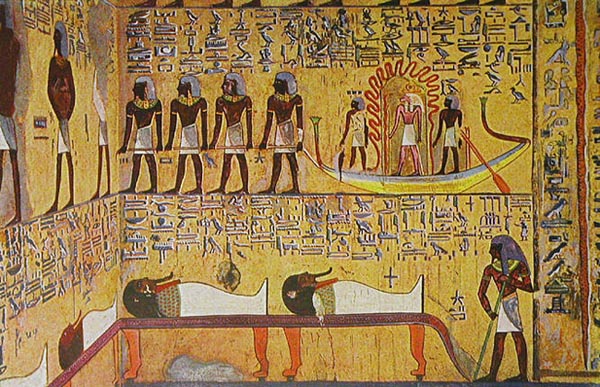
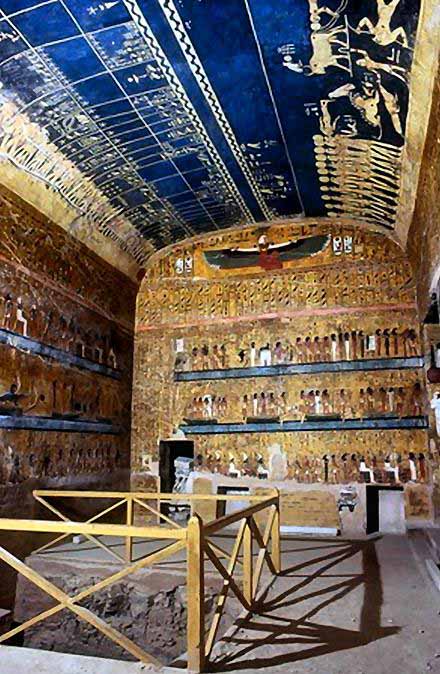
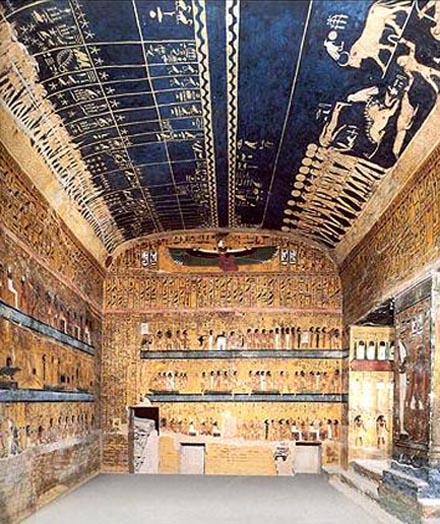
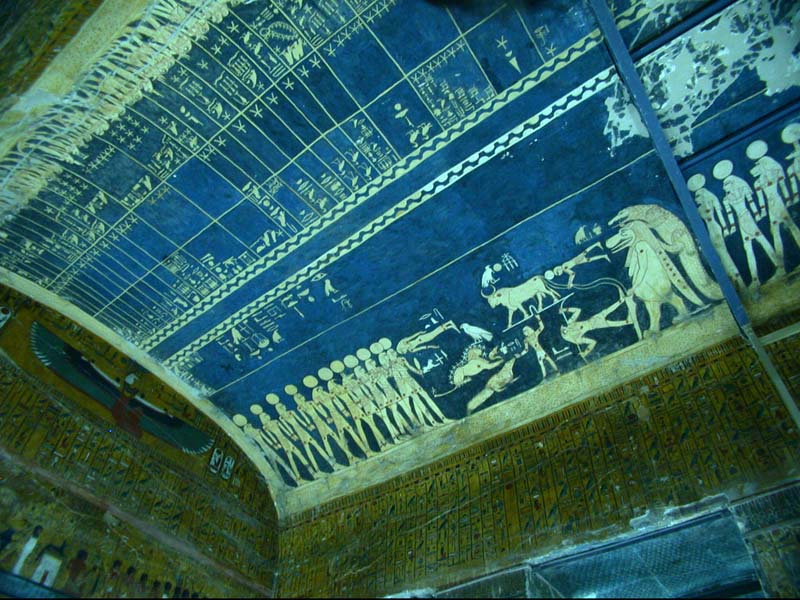
Seti's well preserved tomb (KV17) was found in 1817 by Giovanni Battista Belzoni, in the Valley of the Kings; it proved to be the longest at 136 meters and deepest of all the New Kingdom royal tombs. It was also the first tomb to feature decorations - including The Legend of the destruction of mankind - on every passageway and chamber with highly refined bas-reliefs and colorful paintings - fragments of which, including a large column depicting Seti I with the goddess Hathor, can be seen in the Museo Archeologico, Florence. This decorative style set a precedent which was followed in full or in part in the tombs of later New Kingdom kings. Seti's mummy itself was not discovered until 1881, in the mummy cache (tomb DB320) at Deir el-Bahri, and has since been kept at the Cairo Museum.
His huge sarcophagus, carved in one piece and intricately decorated on every surface (including the goddess Nut on the interior base), is in Sir John Soane's Museum, in London, England; Soane bought it for exhibition in his open collection in 1824, when the British Museum refused to pay the $2,000 demanded. On its arrival at the museum, the alabaster was pure white and inlaid with blue copper sulphate. Years of the London climate and pollution have darkened the alabaster to a buff color and absorbed moisture has caused the hygroscopic inlay material to fall out and disappear completely. A small watercolor nearby records the appearance, as it was.
From an examination of Seti's extremely well-preserved mummy, Seti I appears to have been less than forty years old when he died unexpectedly. This is in stark contrast to the situation with Horemheb, Ramesses I and Ramesses II who all lived to an advanced age. The reasons for his relatively early death are uncertain, but there is no evidence of violence on his mummy.
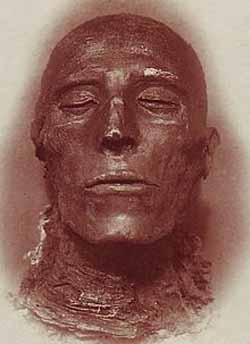
His mummy was found with its head decapitated, but this was likely caused after his death by tomb robbers. The Amun priest carefully reattached his head to his body with the use of linen cloths. It has been suggested that he died from a disease which had affected him for years, possibly related to his heart. The latter was found placed in the right part of the body, while the usual practice of the day was to place it in the left part during the mummification process. Opinions vary whether this was a mistake or an attempt to have Seti's heart work better in his afterlife. Seti I's mummy is about 1.7 metres (5 ft 7 in) tall.